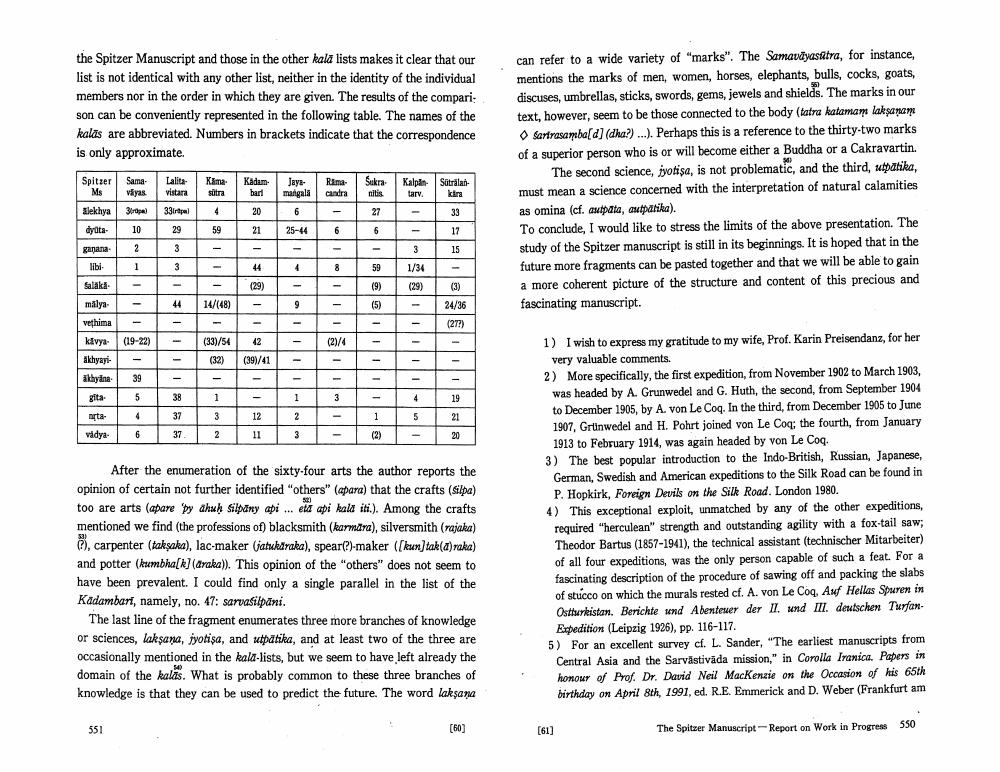Book Title: Spitzer Manuscript Report On Work In Progress Author(s): Eli Franco Publisher: Eli Franco View full book textPage 7
________________ the Spitzer Manuscript and those in the other kalā lists makes it clear that our list is not identical with any other list, neither in the identity of the individual members nor in the order in which they are given. The results of the compari son can be conveniently represented in the following table. The names of the kalās are abbreviated. Numbers in brackets indicate that the correspondence is only approximate. Spitzer Sama- Lalita- K&ma- Kādam. Ms vayas. vistara sütra barl Alekhya 3rdpa) 33(rap) 4 20 dyüta 10 29 59 21 3 3 ganana. libi Salākā. malya- - vethima kavya- (19-22) akhyayi akhyāna gita. nrta vidya 2 1 551 - - - 39 5 4 6 - 44 - - 38 37 37. - - 14/(48) (33)/54 (32) - 1 3 2 - 44 (29) - 42 (39)/41 12 11 Jaya- Rama- Sukramangala candra nitis. 6 27 25-44 4 9 -- - - 1 2 3 6 - 8 — (2)/4 3 - 6 - 59 (9) (5) - 1 (2) Kalpan Süträlan tarv. kira 33 - - 3 1/34 (29) - - - 4 5 17 15 - (3) 24/36 (27?) - 19 21 20 After the enumeration of the sixty-four arts the author reports the opinion of certain not further identified "others" (apara) that the crafts (silpa) too are arts (apare by ahuḥ silpany api... eta api kala iti.). Among the crafts mentioned we find (the professions of) blacksmith (karmara), silversmith (rajaka) P), carpenter (takṣaka), lac-maker (jatukäraka), spear(?)-maker ([kun]tak(α) raka) and potter (kumbha[k] (araka)). This opinion of the "others" does not seem to have been prevalent. I could find only a single parallel in the list of the Kadambari, namely, no. 47: sarvasilpāni. 53) The last line of the fragment enumerates three more branches of knowledge or sciences, lakṣaṇa, jyotisa, and utpatika, and at least two of the three are occasionally mentioned in the kala-lists, but we seem to have left already the domain of the kalas. What is probably common to these three branches of knowledge is that they can be used to predict the future. The word lakṣaṇa [60] can refer to a wide variety of "marks". The Samavayasutra, for instance, mentions the marks of men, women, horses, elephants, bulls, cocks, goats, discuses, umbrellas, sticks, swords, gems, jewels and shields. The marks in our text, however, seem to be those connected to the body (tatra katamam lakṣaṇam Sartrasamba[d] (dha?)...). Perhaps this is a reference to the thirty-two marks of a superior person who is or will become either a Buddha or a Cakravartin. The second science, jyotisa, is not problematic, and the third, utpatika, must mean a science concerned with the interpretation of natural calamities as omina (cf. autpata, autpatika). To conclude, I would like to stress the limits of the above presentation. The study of the Spitzer manuscript is still in its beginnings. It is hoped that in the future more fragments can be pasted together and that we will be able to gain a more coherent picture of the structure and content of this precious and fascinating manuscript. 1) I wish to express my gratitude to my wife, Prof. Karin Preisendanz, for her very valuable comments. 2) More specifically, the first expedition, from November 1902 to March 1903, was headed by A. Grunwedel and G. Huth, the second, from September 1904 to December 1905, by A. von Le Coq. In the third, from December 1905 to June 1907, Grünwedel and H. Pohrt joined von Le Coq; the fourth, from January 1913 to February 1914, was again headed by von Le Coq. 3) The best popular introduction to the Indo-British, Russian, Japanese, German, Swedish and American expeditions to the Silk Road can be found in P. Hopkirk, Foreign Devils on the Silk Road. London 1980. 4) This exceptional exploit, unmatched by any of the other expeditions, required "herculean" strength and outstanding agility with a fox-tail saw; Theodor Bartus (1857-1941), the technical assistant (technischer Mitarbeiter) of all four expeditions, was the only person capable of such a feat. For a fascinating description of the procedure of sawing off and packing the slabs of stucco on which the murals rested cf. A. von Le Coq, Auf Hellas Spuren in Osturkistan. Berichte und Abenteuer der II. und III. deutschen TurfanExpedition (Leipzig 1926), pp. 116-117. 5) For an excellent survey cf. L. Sander, "The earliest manuscripts from Central Asia and the Sarvästiväda mission," in Corolla Iranica. Papers in honour of Prof. Dr. David Neil MacKenzie on the Occasion of his 65th birthday on April 8th, 1991, ed. R.E. Emmerick and D. Weber (Frankfurt am The Spitzer Manuscript-Report on Work in Progress 550 [61]Page Navigation
1 ... 5 6 7 8 9 10
